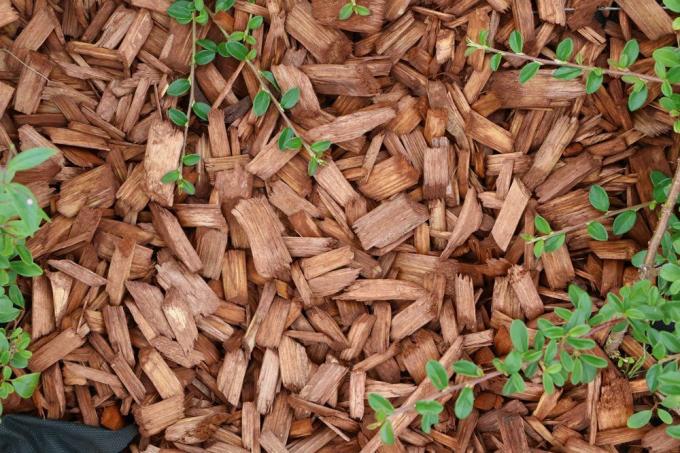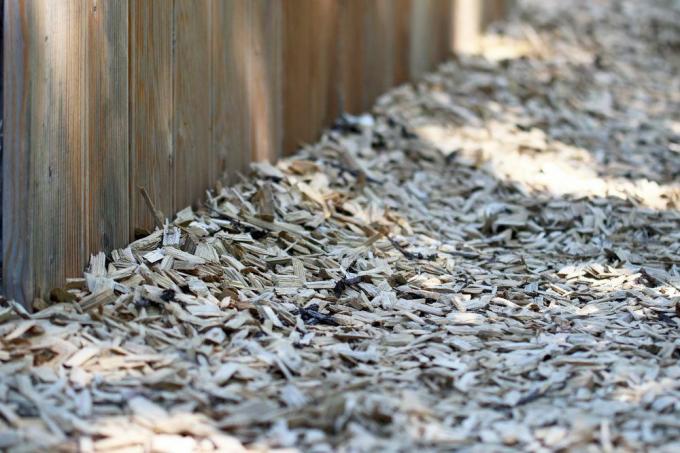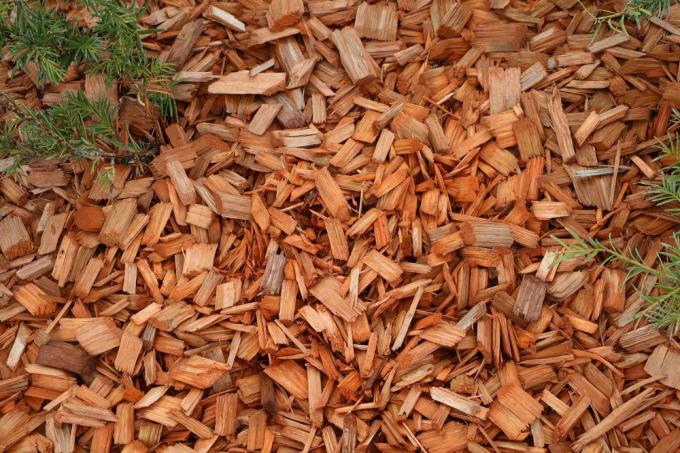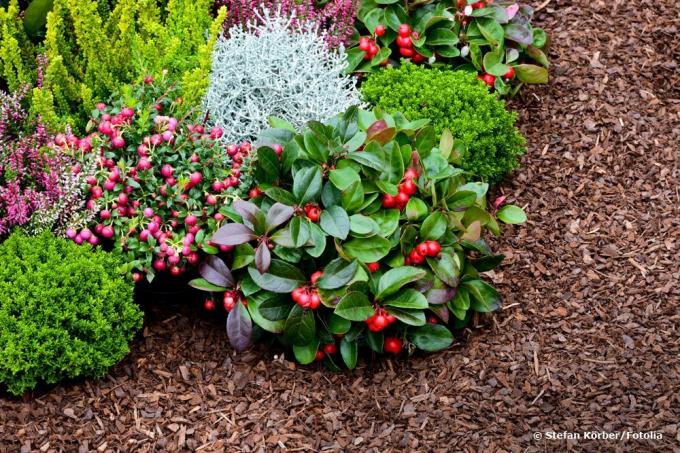
table of contents
- Not all mulch is created equal
- Quality pays off
- Not suitable for all plants
- Use bark mulch correctly
- advantages
- disadvantage
Hardly any hobby gardener can do without bark mulch. It not only serves optical purposes, but also protects soil and plants. You have copied it from nature. But not every mulch is equally suitable for every soil or every plant. In addition, there are sometimes very large differences in quality when it comes to the mulch itself. There are also several things to consider when choosing the right product and its application.
Not all mulch is created equal
Bark mulch is chopped tree bark, a waste product from forestry. Usually, mulch contains the tree bark native to the tree Conifers like pine, Spruce or Douglas fir. It is offered in stores in different qualities and grains, sometimes even in different colors, naturally colored. Only pine bark from the Mediterranean area, which is also available in stores and can be found in more and more gardens, has an intense rust-red color by nature. Pine bark mulch is said to be the best one can buy in this country.
Quality pays off
There are huge differences in the quality, especially in the composition of bark mulch. There are neither regulations nor a standard as to how it must be designed. In theory, it doesn't even have to be made of tree bark. In the worst case, there is even the possibility that what is offered as bark mulch is one hundred percent foreign matter. In some cases, too high a cadmium exposure is criticized. Cadmium is a heavy metal that is classified as very toxic. It is also dangerous to mention that not every product is so polluted. But how can you recognize high-quality mulch?
- An important quality feature of mulch is the smell
- Fresh mulch smells pleasantly of forest and essential oils
- The older the material, the more earthy the smell
- Composition another indicator of quality
- Many products often contain cheap mulch
- Cheap products are often contaminated with unscreened foreign matter
- Mulch with a low percentage of tree bark contains less tannin
- Weeds are therefore not suppressed as effectively
- In inferior products, mulch very fine or even powdery
- Fine material rots very quickly
- Can hinder oxygen exchange in the soil
- High quality mulch contains larger parts of peeled tree bark
- What is important is a structure or Bark size from 16 to 40 mm
- Good quality mulch will keep its shape longer
- The positive effect lasts longer accordingly
- This is the most important indication of good quality RAL quality mark 250 / 1-1
- Products with this seal of approval have not been chemically treated
As a Mercedes among the mulch types Pine mulch. It should be of the best quality. Pine bark has a high Resin contentwhich has the property of making the mulch durable for a very long time. But there are also restrictions here, because even if the product says 'Pure Pine', that is no guarantee that it actually contains pine. Often there is also normal mulch made from softwood bark in it.
Not suitable for all plants
Mulch is undoubtedly good and recommendable for many things in the garden. However, there is one in some plants intolerance compared to bark mulch. For all acid and humus-loving plants such as. z. B. rhododendron, Hydrangeas or ferns, mulching is a must as well as for perennials in the shade, Roses and freshly planted trees, bushes and hedges as well as on larger open spaces. You particularly benefit from it.
It looks different with Perennials and flowers in the garden that cannot tolerate permanent moisture or that rely on a more alkaline pH value. Also vegetable patches, Raspberries and Strawberries it is better not to mulch at all. They are more grateful for a layer of straw or clippings.
Use bark mulch correctly
There is also often a lack of clarity about how to properly apply mulch in the garden. It's all about finding the right one time and the thickness. The best time to apply mulch is in autumn, but it is possible all year round. The coarser the material, the thicker the layer can be. Usually five to seven centimeters are recommended. Before spreading, the soil should be well loosened, cleared of any weeds and fertilized, especially with nitrogen, because the mulch removes this from the soil. But chopped tree bark not only has disadvantages, but also a lot of advantages.
advantages
The advantages of mulch are very diverse and widely known, both for the soil condition and the plants growing on it. It is applied as the top layer on the ground, where it can fulfill its purpose and develop its effect.
- Mulch promotes the settlement of microorganisms
- This improves the soil structure and fertility
- With sufficient thickness, protection against natural soil erosion
- This prevents the topsoil from being washed away
- High quality mulch regulates soil temperature and moisture in the soil
- Even in summer with persistent heat and drought
- Bark material offers protection against dehydration and frost in winter
- Prevents or suppresses excessive weed growth
- The tannic acid it contains is responsible for this
- Leads to a significant reduction in workload
- Mulch offers shelter and habitat for many small animals or insects
- Costs for conventional bark mulch are manageable
- Chopped tree bark also has a decorative effect
- Mulched areas give a clean and well-kept impression
This is a special case Pine bark, which in popularity, is leaving conventional mulch more and more behind. The reason for this is the good quality and other advantages. Pine mulch, for example, has a lower acid content and thus affects the pH value of the soil significantly less than conventional mulch. It lasts more than twice as long as the bark of local conifers and the cadmium load is also much lower. Pine bark can also weed suppress as much as possible. It rots more slowly than pine or spruce and is also available in different grain sizes. Their typical red-brown color also ensures a neat look. The good quality of pine bark is also confirmed by the RAL seal of approval.
disadvantage
In addition to the many good properties, both mulch from domestic conifers and pine mulch have one or the other disadvantage that should not be ignored.
- There is intolerance to some plants
- Conifer mulch removes nitrogen from the soil
- Withdrawal of nitrogen occurs during the rotting process
- This temporarily leads to a nitrogen deficiency
- Especially problematic for shallow roots
- As a preventive measure, fertilize the soil with nitrogen before mulching
- Bark mulch attracts not only useful animals, but also snails
- Snails use mulch as a shelter and to lay eggs
- Especially when the bark mulch is wet
- In order not to attract them additionally, only use pre-dried mulch
- Mulch only in dry weather
- Moisture then does not build up so quickly under the bark material
Even if pine bark is generally supposed to be very good, it also has disadvantages. One of them is the lower level of Tannic acidwhich leads to the fact that the weed control is not optimal. Accordingly, the soil must be prepared all the more carefully and weeds cleared before mulching. The long transport routes are also disadvantageous, because pine trees are not indigenous Woods. Ultimately, it is also a question of price which type of mulch you choose, although the costs for pine mulch are slightly higher than those for bark mulch made from pine, spruce and Douglas fir.







